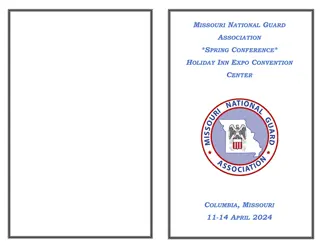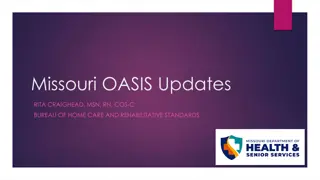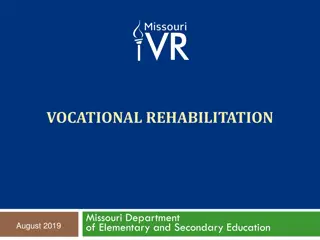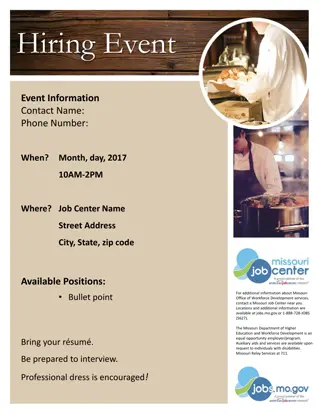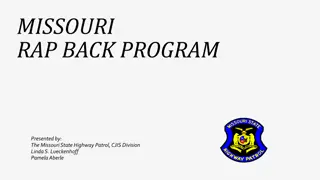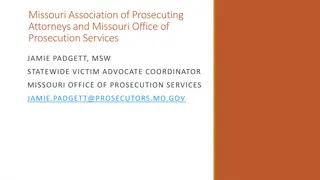Missouri Case Law Update 2023: Kurbursky v. Independent In-Home Services, LLC
In the case of Kurbursky v. Independent In-Home Services, LLC, the court addressed the calculation of benefits for part-time employees in Missouri workers' compensation cases. The dispute centered around the average weekly wage for a part-time employee and the interpretation of statutory provisions regarding full-time versus part-time status. Employee testimonies, legal interpretations, and stipulated facts led to a remand for the Commission to determine the appropriate compensation based on full-time worker standards.
Download Presentation

Please find below an Image/Link to download the presentation.
The content on the website is provided AS IS for your information and personal use only. It may not be sold, licensed, or shared on other websites without obtaining consent from the author.If you encounter any issues during the download, it is possible that the publisher has removed the file from their server.
You are allowed to download the files provided on this website for personal or commercial use, subject to the condition that they are used lawfully. All files are the property of their respective owners.
The content on the website is provided AS IS for your information and personal use only. It may not be sold, licensed, or shared on other websites without obtaining consent from the author.
E N D
Presentation Transcript
2023 Missouri Case Law Update Presented by Michael Kelly and Danny Schmitz
Kurbursky v. Independent In- Home Services., LLC 648 S.W.3d 894 (Mo. Ct. App. 2022) 287.250.3 If an employee is hired by the employer for less than the number of hours per week needed to be classified as a full-time or regular employee, benefits computed for purposes of this chapter for permanent partial disability, permanent total disability and death benefits shall be based upon the average weekly wage of a full-time or regular employee engaged by the employer to perform work of the same or similar nature and at the number of hours per week required by the employer to classify the employee as a full-time or regular employee, but such computation shall not be based on less than thirty hours per week.
Kurbursky v. Independent In- Home Services., LLC 648 S.W.3d 894 (Mo. Ct. App. 2022) Final Hearing 10/18/19 Employee testified she worked between 20-25 hours per week for the employer Employee testified she was a part-time Employee Employee testified she earned $7.65/hour Employee testified there were about three other employees performing the same job in a full-time capacity LIRC 04/07/21 If the Missouri legislature simply wanted us to calculate part-time employees at a rate of a full-time worker at 40 hours, then the legislature could have directed us to do so. However, the current wording of the statute does not state that, and the current approach taken by the Commission makes the most sense based on the statute as it is currently written. Based on that, we use a 30 hour work week, since, under 287.250, it represents the closest to the actual amount of hours worked by employee per week that is allowed under that statute.
Kurbursky v. Independent In- Home Services., LLC 648 S.W.3d 894 (Mo. Ct. App. 2022) Court of Appeals Southern District Reversed and remanded for the Commission to make factual findings on the average weekly wage of a full-time or regular employee engaged by [E]mployer to perform work of the same or similar nature and the number of hours required by Employer to classify an employee as a full-time or regular employee and to then calculate its award based upon those findings. 287.250.3 Remand Hearing 09/29/22 Parties stipulated that a full-time worker worked 40 hours per week Parties stipulated that Employee was paid at an hourly rate of $7.65 Parties stipulated that Employee s AWW was $306.00, with a PPD rate of $204.00
Lamy v. Stahl Speciality Co. 649 S.W.3d 330 (Mo. Ct. App. 2022) Employee alleged a repetitive trauma injury to his left upper extremity Date of occupational disease 08/26/16 Left shoulder surgery with Dr. McNamara on 10/11/16 02/13/17 Dr. McNamara indicates Employee still has carpal tunnel syndrome in the left wrist that might require future attention 03/13/17 Dr. McNamara releases Employee without restrictions 04/10/17 MMI 11/09/17 Dr. Stuckmeyer IME Employee requires additional treatment for his left shoulder In the absence of additional treatment, Employee has 35% PPD of the left shoulder Employee also requires additional treatment for his work-related left carpal tunnel syndrome
Lamy v. Stahl Speciality Co. 649 S.W.3d 330 (Mo. Ct. App. 2022) 05/02/18 Employee settles his Claim for 12.5% PPD of the left shoulder 06/26/18 Employee files a new Claim for Compensation for the repetitive trauma injury to the left wrist Date of occupational disease 02/13/17 08/19/19 Dr. McNamara authors a report opining that Employee s current left hand complaints were related to the repetitive work injury that had been the subject of the August 2016 claim
Lamy v. Stahl Speciality Co. 649 S.W.3d 330 (Mo. Ct. App. 2022) Final Hearing 05/04/21 Employer argues Employee s request for medical benefits and compensation for the left wrist is barred by the prior settlement of the 08/26/16 injury ALJ concludes the prevailing factor for Employee s left carpal tunnel syndrome was the same as the prevailing factor for his left shoulder injury: the repetitive work activities that gave rise to the August 2016 claim Employee voluntarily elected to settle his August 2016 claim with the knowledge that both Dr. McNamara and Dr. Stuckmeyer had diagnosed him with left carpal tunnel syndrome that might require future surgery, and with the knowledge that the compromise settlement settled all issues between the parties. LIRC affirms On appeal, Employee argued the compromise settlement only bound the parties with respect to the left shoulder injury
Lamy v. Stahl Speciality Co. 649 S.W.3d 330 (Mo. Ct. App. 2022) Court clarified Employee was challenging whether the LIRC s uncontested factual findings support a legal conclusion that the compromise settlement foreclosed the LIRC s jurisdiction to consider the February 2017 claim for injury to his left wrist Employee contended that the compromise settlement was limited in its scope to settlement of his left shoulder injury claim Dr. McNamara s 08/19/19 letter underscores that Employee knew he had a repetitive trauma injury to his left wrist (a portion of his left upper extremity) when he saw Dr. McNamara back in August 2016, and before he entered into the compromise settlement Nevertheless, Employee settled all issues with Employer involving his August 2016 claim for repetitive injury to the left upper extremity LIRC did not improperly rely on Miller v. U.S. Airways Group, Inc., 316 S.W.3d 462 (Mo. App. W.D. 2010), which dismissed successive claims for bilateral carpal tunnel syndrome as a result of repetitive trauma LIRC did not commit legal error when it concluded that the compromise settlement exhausted its jurisdiction to entertain Employee s February 2017 claim
Watson v. Tuthill Corporation No. SD 37293, 2023 WL 4614768 (Mo. Ct. App. July 19, 2023) Employee worked 28 years for Employer, most of which was spent as a service technician, tearing down and repairing rotary air equipment April 2015 Employee s lower back popped when he caught a falling motor Employee underwent a lumbar fusion in August 2015 Surgery improved, but did not resolve Employee s symptoms January 2016 Employee returned to full time work performing basically the same tasks he was performing prior to April 2015 Employee had to take breaks to lie down for 10-20 minutes, 3-5 times a day February 2016 Employee twisted his neck and heard a crack/pop while using a pneumatic tool at work Employee treated his neck injury with heat, manipulation, and traction
Watson v. Tuthill Corporation No. SD 37293, 2023 WL 4614768 (Mo. Ct. App. July 19, 2023) Dr. Koprivica (Employee s expert) opined that the April 2015 low back injury alone rendered Employee permanently and totally disabled Dr. Belz (Employer s expert) did not feel Employee s occupational exposure was the prevailing factor in causing Employee s back injury Dr. Belz did not feel Employee was PTD as a result of the back injury alone, nor the neck injury alone, but he acknowledged Employee was PTD when considering the back injury in combination with the neck injury, additional prior injuries, and a non-work-related degenerative condition
Watson v. Tuthill Corporation No. SD 37293, 2023 WL 4614768 (Mo. Ct. App. July 19, 2023) ALJ concluded: April 2015 work injury was the prevailing factor in causing the resulting medical condition and disability in Employee s back. February 2016 work injury was the prevailing factor in causing the resulting medical condition and disability in Employee s neck. Employee is permanently and totally disabled as a result of the April 2015 back injury, considered in isolation. SIF is not liable because the last injury was the back injury, not the neck injury. Commission affirmed.
Watson v. Tuthill Corporation No. SD 37293, 2023 WL 4614768 (Mo. Ct. App. July 19, 2023) Last Injury Employer argued the Commission applied the wrong legal standard in finding that the back injury, not the neck injury, was the last injury for purposes of 287.220.3 RSMo. If a claimant's last injury in and of itself rendered the claimant permanently and totally disabled, then the Second Injury Fund has no liability and employer is responsible for the entire amount. Lewis v. Treasurer of State, 435 S.W.3d 144, 157 (Mo. App. 2014). If the neck injury was the last injury, the extent or percentage of permanent total disability resulting from it was nothing Employer acknowledged the medical experts opined that the neck injury resulted in no impairment or only minor (i.e. 10% or less) permanent partial disability of the body as a whole Accordingly, the ALJ found no permanent total disability resulting from the neck injury
Watson v. Tuthill Corporation No. SD 37293, 2023 WL 4614768 (Mo. Ct. App. July 19, 2023) Last Injury Court of Appeals found substantial evidence supported the ALJ's finding that the back injury alone rendered Employee permanently and totally disabled The occurrence of a subsequent work-related injury does not change the fact that Employee was already permanently and totally disabled at the time of the neck injury The subsequent injury may have added to Employee s misery but did not make him more permanently and totally disabled or combine with his prior back injury to result in permanent total disability An employee can be permanently and totally disabled without becoming completely inactive or inert. Employee good fortune to have returned to highly accommodated employment will not preclude a finding of permanent total disability because The test is whether the claimant could compete in the open labor market.
City of Clinton v. Dahman 669 S.W.3d 142 (Mo. Ct. App. 2023) Employee began working as a police officer for the City of Clinton in January 2011 On 08/06/17, Employee heard a radio report from his friend and fellow officer Gary Michael that shots had been fired and an officer was down Employee responded and found Officer Michael on the ground and alive Employee testified: It was dark outside This was the first officer shooting in which he had been involved The suspect s whereabouts were unknown The suspect s rifle had pierced Officer Michael s protective gear He felt he was a sitting duck He later learned that Officer Michael had passed away
City of Clinton v. Dahman 669 S.W.3d 142 (Mo. Ct. App. 2023) Dr. William Logan, to whom Employee was referred by the City of Clinton, opined that the 08/06/17 event did rise to the level of extraordinary and unusual mental stress for several reasons including: As compared to an officer's death in a large department, the Clinton Police Department was a small organization where the officers were well known to each other, worked as a team, and had personal relationships both inside and outside of work. This is the first officer death in the department. In the 08/06/17 event, Employee was exposed to potentially lethal fire from the suspect. PTSD can also occur on learning that a traumatic event occurred to a close friend such as the relationship Employee had with Officer Michael. Dr. Dale Halfaker, who evaluated Employee at the request of his attorney, similarly believed the event of 08/06/17, and the stress that it caused was both extraordinary and unusual. In support of this conclusion, Dr. Halfaker noted: Employee was in the dark Employee was lit up standing by the car knowing that the person had a rifle Employee knew that the suspect had already killed one police officer so why would he have second thoughts about perhaps killing another City of Clinton also had Employee evaluated by Dr. Sheba Khalid, who agreed that the stress was both extraordinary and unusual
City of Clinton v. Dahman 669 S.W.3d 142 (Mo. Ct. App. 2023) The ALJ concluded, and the LIRC confirmed, that Employee showed by objective standards that his work-related stress was both extraordinary and unusual and meets the requirements of 287.120.8 Despite the contention of the City of Clinton that police officers' shootings are not extraordinary, the particular facts of Employee s experiences, including but not limited to: responding to the scene of Officer Michael's shooting which was a friend of Employee, knowing that the suspect was still at large, knowing that the suspect had a long rifle, knowing that the protective vest would not help if the suspect decided to shot again, and feeling like a sitting duck in the dark All support the conclusion that the work-related stress was both extraordinary and unusual Court of Appeals agreed that sufficient competent evidence supported Commission's conclusion that claimant's post-traumatic stress disorder was caused by work-related stress which was extraordinary and unusual, measured by objective standards and actual events.
Harper v. Springfield Rehab & Health Care Ctr./NHC Health No. SD 37268, 2023 WL 1776279 (Mo. Ct. App. Feb. 6, 2023), reh'g and/or transfer denied (Feb. 24, 2023) Westlaw says this case has been ordered transferred to the Supreme Court On 06/22/18 (Friday), Employee was working the night shift as a nurse for Employer Around midnight, Employee was helping a tech give medications The tech left the medication cart in the hallway, where it presented a hazard for patients Employee strained to move the medication cart and felt a pull in her back Employee continued working, but had difficulty walking Employee reported the injury to the Employer the following Monday
Harper v. Springfield Rehab & Health Care Ctr./NHC Health No. SD 37268, 2023 WL 1776279 (Mo. Ct. App. Feb. 6, 2023), reh'g and/or transfer denied (Feb. 24, 2023) Westlaw says this case has been ordered transferred to the Supreme Court At the Final Hearing, Employer argued Employee s incident on 06/22/18 did not meet the statutory definition of accident under 287.020.2: The word accident as used in this chapter shall mean an unexpected traumatic event or unusual strain identifiable by time and place of occurrence and producing at the time objective symptoms of an injury caused by a specific event during a single work shift. An injury is not compensable because work was a triggering or precipitating factor. The ALJ and LIRC both concluded Employee sustained a compensable injury arising out of and in the course of her employment, and awarded benefits.
Harper v. Springfield Rehab & Health Care Ctr./NHC Health No. SD 37268, 2023 WL 1776279 (Mo. Ct. App. Feb. 6, 2023), reh'g and/or transfer denied (Feb. 24, 2023) Westlaw says this case has been ordered transferred to the Supreme Court On appeal, Employer argued Employee s accident did not meet the statutory definition of an accident because Employee s unusual strain did not produce at the time objective symptoms of an injury. The Court noted: One of the uses of at as a preposition is use as a function word to indicate presence or occurrence in, on, or near. One of the meanings of (1) the noun symptom is something that indicates the existence of something else, and (2) the adjective objective when used in combination with symptom is perceptible to persons other than the affected individual 287.020.3(5) in relevant part defines injury to mean violence to the physical structure of the body.
Harper v. Springfield Rehab & Health Care Ctr./NHC Health No. SD 37268, 2023 WL 1776279 (Mo. Ct. App. Feb. 6, 2023), reh'g and/or transfer denied (Feb. 24, 2023) Westlaw says this case has been ordered transferred to the Supreme Court Combining these meanings, the statutory phrase an unusual strain producing at the time objective symptoms of an injury should be interpreted in the circumstances of this case to mean an unusual strain producing at (i.e., near) the time objective symptoms (i.e., indications perceptible by persons other than Claimant of the existence) of an injury (i.e., violence to the physical structure of Claimant's body). Employee had difficulty walking later in the same shift during which she suffered the unusual strain Employee s difficulty walking would have been perceptible to persons other than Employee, indicated the existence of violence to the physical structure of Employee s body, and was produced near the time of the unusual strain
Second Injury Fund Cases March v. Treasurer of State, 649 S.W.3d 293 (Mo. 2022) Adams v. Treasurer of State, 662 S.W.3d 8 (Mo. Ct. App. 2022) Swafford v. Treasurer of Missouri, 659 S.W.3d 580 (Mo. 2023)
March v. Treasurer of State, 649 S.W.3d 293 (Mo. 2022) Primary Injury: Inoperable bilateral carpal tunnel syndrome Preexisting Disabilities: Morbid obesity Thyroid issues Hypothyroidism Hypertension Transient ischemic attack Atrial fibrillation Asthma 2 left rotator cuff tears Left leg laceration - required treatment for stasis ulcers, affected his ability to stand, and created blood flow issues Bilateral lower extremity condition diagnosed in 2005 with edema and pain radiating down both legs into his ankles
March v. Treasurer of State, 649 S.W.3d 293 (Mo. 2022) Final Hearing The vocational testimony supported a finding that a progression of Employee s bilateral lower condition rendered him unable to compete in the open labor market. Employee s lower extremity condition (which preexisting the work injury) was actively being treated and significantly deteriorated after the work-related accident. There was no aggravation or acceleration of the work-related accident to combine to lead Employee to be PTD. LIRC Disavowed ALJ s findings regarding progression of his bilateral lower extremity condition that rendered him unable to compete in the open labor market. Still were not persuaded that the combination of Employee's preexisting injuries and the primary injury resulted in PTD Equally likely that Employee s preexisting injuries (without the addition of the primary injury) resulted in PTD
March v. Treasurer of State, 649 S.W.3d 293 (Mo. 2022) Court of Appeals Western District LIRC s causation opinion is not supported by any expert medical opinion and is nothing more than the LIRC s person opinion LIRC s Final Award on the issue of causation is not supported by sufficient competent evidence to warrant the making of the Final Award and it must be reversed Supreme Court Burden of production vs. burden of persuasion 287.808 contains no language mandating the Fund present evidence, impeachment or otherwise, unless the Fund wishes to assert an affirmative defense Employee failed to carry his burden of persuasion in demonstrating he was entitled to PTD benefits LIRC could conclude the evidence was equivocal about the issue of whether it was more likely true than not that his preexisting disabilities and primary injuries combined to render him permanently and totally disabled such that the Fund was liable for PTD benefits
Adams v. Treasurer of State 662 S.W.3d 8 (Mo. Ct. App. 2022), reh'g and/or transfer denied (Nov. 22, 2022), transfer denied (Apr. 4, 2023) Employee had three relevant work-related injuries: 1984 left hand settled for 32.5% PPD of the left hand (56.875 weeks) 2001 back, bilateral knees settled for 15% PPD BAW referable to the bilateral knees and low back (60 weeks) Employee s doctor rated Employee at 35% PPD of the right leg, 35% PPD of the left leg, 7.5% PPD BAW (back) Employer s doctor rated Employee at 5% PPD of the right leg, 3% PPD of the left leg, 2% PPD BAW (back) 2015 (primary injury) right hand, right shoulder
Adams v. Treasurer of State 662 S.W.3d 8 (Mo. Ct. App. 2022), reh'g and/or transfer denied (Nov. 22, 2022), transfer denied (Apr. 4, 2023) ALJ found Employee was permanently and totally disabled as a result of the 2015 work injury in combination with the prior 1984 and 2001 injuries Fund appealed, arguing the 2001 injury resulted in disabilities to two specific body parts, the knees and the back, which are separate disabilities that do not separately meet the 50-week threshold LIRC agreed and reversed LIRC found SIF had no liability We find, as a factual matter, that preexisting disability relating to employee's [2001] work injury did not result in PPD of at least fifty weeks to either employee's back or bilateral knees. On appeal to the Western District, the issue was whether the disabilities to Employee s back and bilateral knees which resulted from the 2001 Injury are statutorily required to be considered in combination as a body as a whole in order to satisfy the fifty-week PPD minimum of section 287.220.3(2)(a)a, such to be considered a qualifying preexisting disability
Adams v. Treasurer of State 662 S.W.3d 8 (Mo. Ct. App. 2022), reh'g and/or transfer denied (Nov. 22, 2022), transfer denied (Apr. 4, 2023) In Parker, the Supreme Court expressly addressed the legislative change to limit the Fund's liability by excluding non-qualifying preexisting disabilities from consideration in determining PTD In Klecka, the Supreme Court reiterated that non-qualifying preexisting disabilities cannot be considered in determining whether a claimant satisfies the second condition of section 287.220.3 Court of Appeals acknowledged it is bound by the LIRC s factual determinations that the 2001 Injury resulted in two clearly differentiable disabilities and neither disability resulted in PPD of at least 50- weeks The Compromise Settlement simply agrees to an approximated and cumulative disability rating for purposes of settlement without separately rating the individual disabilities themselves, a function necessary to determine whether either qualifies as a preexisting disability as defined by 287.220.3(2). The Commission has discretion in how it addresses cumulative disabilities.
Swafford v. Treasurer of Missouri 659 S.W.3d 580 (Mo. 2023) Primary Injury: October 2017 slipped while getting out of a truck and was left hanging by his right arm Preexisting Disabilities: Ankylosing spondylitis ( AS ) a congenital condition causing his spine and rib bones to fuse together over time and resulting in constant pain, difficulty breathing, curved posture, and a limited range of motion. Various cardiac conditions Required multiple procedures, including hypertrophic cardiomyopathy, mitral valve regurgitation, and atrial fibrillation. Right-shoulder pain since 2012, which was associated with his repetitive single-handed cranking of jacks used to adjust the height of semi-trailers. In 2016, he was diagnosed with bursitis in his right shoulder, which required steroid injections every 3-4 months.
Swafford v. Treasurer of Missouri 659 S.W.3d 580 (Mo. 2023) Employee settled his primary claim with the Employer and proceeded against the Fund for PTD benefits Dr. Erich Lingenfelter and Dr. Brent Koprivica both testified about the synergistic effect between Employee s primary injury and his preexisting disabilities ALJ and LIRC denied Employee s claim for PTD against the Fund Employee failed to show his preexisting disabilities directly and significantly aggravated or accelerated his primary injury pursuant to 287.220.3(2)(a)a(iii)
Swafford v. Treasurer of Missouri 659 S.W.3d 580 (Mo. 2023) Employee appealed, arguing his preexisting qualifying disability directly or significantly aggravated or accelerated his primary workplace injury Court of Appeals emphasized that the LIRC did not disregard, ignore, or reject Employee s medical opinions from Dr. Lingenfelter or Dr. Koprivica The LIRC simply determined that the evidence was insufficient to prove his claim under 287.220.3(2)(a)a(iii) While Employee s experts established that Employee s preexisting disabilities had some worsening effect on his primary injury, the LIRC did not err in concluding those reports were insufficient to show that worsening effect rose to the level of significant and direct aggravation or acceleration
Swafford v. Treasurer of Missouri 659 S.W.3d 580 (Mo. 2023) Webster's Third New International Dictionarydefines aggravate as to burden and to add weight to and accelerate as to hasten the ordinary progress or the development of and increase the rate or amount of. As such, the aggravate or accelerate requirement can be interpreted to mean the preexisting disabilities must exacerbate the primary injury in some way. But that alone is not enough; the preexisting disabilities must directly and significantly exacerbate the primary injury. Significant is defined as deserving to be considered and direct is defined as characterized by or giving evidence of a close especially logical, casual, or consequential relationship. Hence, the impact of the preexisting disabilities on the primary injury must be more than incidental; they must clearly exacerbate the primary injury in a meaningful way. The requirement that a qualifying preexisting disability combine with or, in Dr. Lingenfelter's terms, contribute to an employee s PTD is distinct from whether it directly and significantly aggravates or accelerates the employee's primary injury.




